Alfa Romeo 6C
| Alfa Romeo 6C | |
|---|---|
 Alfa Romeo 6C 2500 Touring Berlina | |
| Overview | |
| Manufacturer | Alfa Romeo |
| Production | 1927–1954 |
| Assembly | Portello, Milan, Italy |
| Body and chassis | |
| Class | Luxury car, Sports car, Racing car |
| Layout | Front-engine, rear-wheel-drive |
| Powertrain | |
| Engine | Straight-six |
| Chronology | |
| Predecessor | Alfa Romeo RM |
| Successor | Alfa Romeo 1900 |
The Alfa Romeo 6C name was used on road, race, and sports cars produced between 1927 and 1954 by Alfa Romeo; the "6C" name refers to six cylinders of the car's straight-six engine. Bodies for these cars were made by coachbuilders such as James Young, Zagato, Touring, Castagna, and Pininfarina. Starting from 1933 there was also a 6C version with a factory Alfa body, built in Portello. In the early 1920s Vittorio Jano got a task to create a lightweight, high performance vehicle to replace the Giuseppe Merosi designed RL and RM models. The car was introduced in April 1925 at the Salone dell’ Automobile di Milano as the 6C 1500. It was based on the P2 racing car, using single overhead cam 1,487 cc inline six-cylinder motor producing 44 horsepower, in the 1928 was presented the 1500 Sport which was the first Alfa Romeo road car with double overhead camshafts.
6C 1500 (1927–1929)
| Alfa Romeo 6C 1500 | |
|---|---|
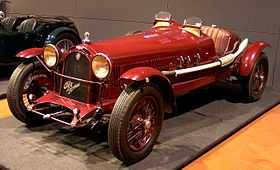 6C 1500 Super Sport 1929 from Louwman Collection | |
| Overview | |
| Production | 1927–1929 |
| Powertrain | |
| Engine | 1.5 L 1487 cc I6 |
| Dimensions | |
| Wheelbase | 2,921 mm (115 in)[1] |
In the mid-1920s, Alfa's RL was considered too large and heavy, so a new development began. The 2-liter formula that had led to Alfa Romeo winning the Automobile World Championship in 1925, changed to 1.5 liter for the 1926 season. The 6C 1500 was introduced in 1925 at the Milan Motor Show, production started 1927,[2] with the P2 Grand Prix car as starting point. Engine capacity was now 1487 cc, against the P2's 1987 cc, while supercharging was dropped. First versions were bodied by Young and Touring.
In 1928, a 6C Sport was released, with a dual overhead camshafts engine. Its sport version won many races, including the 1928 Mille Miglia. Total production was 3000 (200 with DOHC engine). Ten copies of a supercharged (compressore, compressor) Super Sport variant were also made.[1]
Specifications
| Model | Engine | Max power | Fuel system | Top speed | Years | Number produced |
|---|---|---|---|---|---|---|
| 1500 Normale | 1,487 cc (90.7 cu in) SOHC I6 | 44 bhp (33 kW) @ 4400 rpm | single carburetor | 109 km/h (68 mph) | 1925–1929 | |
| 1500 Sport | 1,487 cc (90.7 cu in) DOHC I6 | 54 bhp (40 kW) @ 4500 rpm | single carburetor | 125 km/h (78 mph) | 1928–1929 | 171 |
| 1500 Super Sport | 1,487 cc (90.7 cu in) DOHC I6 | 60 bhp (45 kW) | single carburetor | - | - | |
| 1500 Super Sport compressore | 1,487 cc (90.7 cu in) DOHC I6 | 76 bhp (57 kW) @ 4800 rpm | single carburetor, supercharger | 140 km/h (87 mph) | 1928–1929 | 10 |
| 1500 TF | 1,487 cc (90.7 cu in) DOHC I6 | 84 bhp (63 kW) @ 5000 rpm | single carburetor, supercharger | - | 1928–1929 | |
| Total: 3000 | ||||||
-
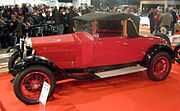
6C 1500 Drophead Coupe by James Young (1928)
-

6C 1500 Sport Zagato Spider (1928)
6C 1750 (1929–1933)
| Alfa Romeo 6C 1750 | |
|---|---|
 6C Gran Sport (1931) | |
| Overview | |
| Production | 1929–1933 |
| Powertrain | |
| Engine | 1.7 L 1752 cc I6 |
| Dimensions | |
| Wheelbase |
122 in (3,099 mm) Turismo 108 in (2,743 mm)/114 in (2,896 mm) Gran Turismo[3] |
The more powerful 6C 1750 (1752 cc actual) was introduced in 1929 in Rome. The car featured a top speed of 95 mph, a chassis designed to flex and undulate over wavy surfaces, as well as sensitive geared-up steering.[4] It was produced in six series between 1929 and 1933. Base model had a single overhead cam; Super Sport and Gran Sport versions had double overhead cam engine (DOHC). Again, a supercharger was available. Most of the cars were sold as rolling chassis and bodied by coachbuilders such as Zagato, and Touring. Additionally, there were 3 examples built with James Young bodywork, one of which is a part of the permanent collection at the Simeone Foundation Automotive Museum in Philadelphia, PA, USA in original, unrestored condition.[4]
In 1929, it won every major racing event it was entered, including the Grands Prix of Belgium, Spain, Tunis and Monza, as well as the Mille Miglia was won with Giuseppe Campari and Giulio Ramponi, the Brooklands Double Twelve and the Ulster TT was won also, in 1930 it won again the Mille Miglia and Spa 24 Hours.[5] Total production was 2635.
Specificatuins
| Model | Engine | Max power | Fuel system | Top speed | Years | Number produced |
|---|---|---|---|---|---|---|
| 1750 Turismo | 1,752 cc (106.9 cu in) SOHC I6 | 46 bhp (34 kW) @ 4000 rpm | single carburetor | 109 km/h (68 mph) | 1929–1933 | |
| 1750 Sport/Gran Turismo | 1,752 cc (106.9 cu in) DOHC I6 | 55 bhp (41 kW) @ 4400 rpm | single carburetor | 125 km/h (78 mph) | 1929–1932 | |
| 1750 Super Sport/Gran Sport | 1,752 cc (106.9 cu in) DOHC I6 | 64 bhp (48 kW) @ 4500 rpm | single carburetor | 130 km/h (81 mph) | 1929–1932 | |
| 1750 Super Sport/Gran Sport compressore | 1,752 cc (106.9 cu in) DOHC I6 | 85 bhp (63 kW) @ 4500 rpm | single carburetor, supercharger | 145 km/h (90 mph) | 1929–1932 | |
| 1750 Gran Turismo compressore | 1,752 cc (106.9 cu in) DOHC I6 | 80 bhp (60 kW) @ 4400 rpm | single carburetor, supercharger | 135 km/h (84 mph) | 1931–1932 | |
| 1750 Super Sport/Gran Sport/TF | 1,752 cc (106.9 cu in) DOHC I6 | 85 bhp (63 kW) @ 4800 rpm | single carburetor, supercharger | 170 km/h (110 mph) | 1929–1930 | |
| Total: 2635 | ||||||
-
6C 1750 GTC Touring (1931)
-
6C 1750 Super Gran Sport Testa Fissa (1931)[1]
-
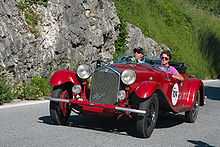
6C 1750 GTC (1932)
-
6C 1750 GS Zagato
- ^ "Alfa Romeo 6C 1750 Gran Sport Testa Fissa". louwmanmuseum.nl. Retrieved 2012-01-16.
6C 1900 (1933)
| Alfa Romeo 6C 1900 | |
|---|---|
|
6C 1900 Gran Sport (1933) at Auto e Moto d'Epoca 2008. | |
| Overview | |
| Production | 1933 |
| Powertrain | |
| Engine | 1.9 L 1917 cc I6 |
| Dimensions | |
| Wheelbase | 2,921 mm (115.0 in)[6] |
| Kerb weight | 1,250 kg (2,756 lb)[6] |
The last derivative of the original 1500 version, the 6C 1900 with an 1917 cc engine, was introduced in 1933, now with an aluminium head for the first time. With 68 brake horsepower this version could achieve a top speed of 130 kilometres per hour (81 mph). The 1900 version is very rare as only 197 copies were made before it was replaced by the 6C 2300.
Specifications
| Model | Engine | Max power | Fuel system | Top speed | Years | Number produced |
|---|---|---|---|---|---|---|
| 1900 GT | 1,917 cc (117.0 cu in) SOHC I6 | 68 bhp (51 kW) @ 4500 rpm | single carburetor | 130 km/h (81 mph) | 1933 | 197 |
6C 2300 (1934–1937)
| Alfa Romeo 6C 2300 | |
|---|---|
 6C 2300B Touring | |
| Overview | |
| Production | 1934–1937 |
| Powertrain | |
| Engine | 2.3 L 2309 cc I6 |
The 6C 2300 (2309 cc) was designed by Vittorio Jano as a lower-cost alternative to the 8C. In 1934 Alfa Romeo had become a state-owned enterprise. This year was presented a new 6C model with a newly designed, larger engine. Chassis technology, however, had been taken from the predecessor. One year later, a revised model, called the 6C 2300 B was presented. In this version the engine was placed in a completely newly designed chassis, with individual front suspension and rear swing axle, and hydraulic brakes. The 6C-2300 was produced in 760 copies with rigid axles and 870 copies of the B-model.
Specifications
| Model | Engine | Max power | Fuel system | Top speed | Years | Number produced |
|---|---|---|---|---|---|---|
| 6C 2300 Turismo | 2,309 cc (140.9 cu in) DOHC I6 | 68 bhp (51 kW) @ 4400 rpm | single carburetor | 120 km/h (75 mph) | 1934 | |
| 6C 2300 Gran Turismo | 2,309 cc (140.9 cu in) DOHC I6 | 76 bhp (57 kW) @ 4400 rpm | single carburetor | 130 km/h (81 mph) | 1934 | |
| 6C 2300B Gran Turismo | 2,309 cc (140.9 cu in) DOHC I6 | 76 bhp (57 kW) @ 4400 rpm | single carburetor | 130 km/h (81 mph)[7] | 1935–1937 | |
| 6C 2300 Pescara | 2,309 cc (140.9 cu in) DOHC I6 | 95 bhp (71 kW) @ 4500 rpm | double carburetor | 145 km/h (90 mph)[8] | 1934 | 60[9] |
| 6C 2300B Pescara | 2,309 cc (140.9 cu in) DOHC I6 | 95 bhp (71 kW) @ 4500 rpm | double carburetor | 145 km/h (90 mph)[10] | 1935–1937 | 120[11] |
| 6C 2300 B Corto/Lungo | 2,309 cc (140.9 cu in) DOHC I6 | - | - | - | 1935 | |
| 6C 2300 B Mille Miglia | 2,309 cc (140.9 cu in) DOHC I6 | - | - | - |
-
6C 2300 Pescara 1934
-
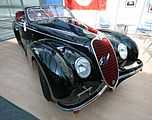
6C 2300 Touring Spider
-

6C 2300B Mille Miglia Spider (1938 )
-

6C 2300B Pescara Berlinetta (1937)
-

6C 2300B Touring Superleggera Coupe
-

6C 2300 S Touring Pescara Spider (1935)
1936 Mille Miglia entrant and ex Benito Mussolini car[1] -
6C 2300 B "Pescara" (1937)
-

6C 2300B Ministeriale (1938 )
- ^ "1935 Alfa Romeo 6C 2300 Sport Spyder". kidston.com. Retrieved 2012-01-21.
Aerodinamica Spider
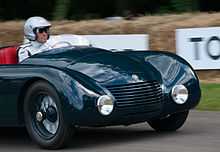

In 1935, the brothers Gino and Oscar Jankovitz, started the project of a one-off mid-engine prototype on an own, ladder-type chassis, powered by an Alfa Romo 6C2300 Turismo engine (no. 700316 in 1934 from a Berlina). The brothers Jankovitz were inspired, for their prototype, called the Alfa Romeo Aerodinamica Spider, by Paul Jaray's aerodynamic theories ponton styling — a genre that would overtake automobile styling and last until the 1960s.
Based on documents kept in the family Jankovits the history of the car's development is as follows: summary of the "Aerospider" Alfa Romeo Jankovits - 6 C 2300 Aerodinamica Spider "Aerospider" (constructed 1934–1937)
The construction of the car took many years, and the result differed somewhat from the earliest drawings, while retaining a strong ladder type chassis fitted with US-sourced suspension components. The aerodynamically interesting body, a quite heavy steel construction with high and large windshield, was fitted to the car years later as the rolling chassis had already been registered in Fiume (I) (2757 FM) before the war.
The Aerospider represents
- The first supercar of “modern” sports car design.
- The first mid-engined car with central driving position (albeit Lancia deposited a patent for a central driven design in 1934).
- The first car designed to take account of newly developed principles of aerodynamics, to provide low-drag both externally and internally.
It had:
- flowing lines with a low body profile, a steep short radiator grille and a long descending tail; side wings with a convex surface at each side of the car, and concave surfaces towards the midline, resulting in a cross-section resembling a bat
- a straight upper line to the silhouette of the side of the car, without interruptions or steps
- a streamlined bodyshell which minimised disturbance to the air flow. For the first time in car design door handles and lights were integrated into the body of the car
- a body design with air inlets in zones of high air pressure, and with the outlets of heated air from the engine and brakes in areas of low pressure.
The first car which was designed for high speeds by using:
- a body which fully enveloped the underside of the car to reduce air turbulence beneath it
- an aerodynamic front design to reduce front lift of the car
This aerodynamic design was in some respects advanced for its times, and a forerunner of modern sports car.
The car had some advanced features for being a pre-war project. It was the first car in history to use:
- a two-circuit brake system with adjustable duplex brakes, with an equaliser which could avoid overbraking by changing the distribution of braking force between the front and rear brakes during driving.
- a hydraulically assisted clutch
- a horizontal radiator which made it possible to design the lowest front profile of any pre-war car
- “silent bloc” bushes
- disc style flexible couplings, later called “Hardy discs”
- exhaust pipes of equal length for better performance
- improved intake of air to reduce the pressure drop
- a unique system of gear change with pre-selection
- features which were designed to avoid the specific problems of a mid-engined racing car, such as overheating and abrupt spinning, which had still not been fully resolved 30 years later.
Technical description
- Dimensions:
- length: 4,750 mm (187.0 in)
- width: 1,720 mm (67.7 in)
- height: 1,030 mm (40.6 in) (1,150 mm (45.3 in) with windscreen)
- wheelbase: 2,800 mm (110.2 in)
- track: 1,560 mm (61.4 in) (front), 1,505 mm (59.3 in) (rear)
- weight: 950 kg (2,090 lb) (dry)
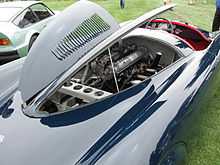
Engine: Alfa Romeo 6 C 2300 engine tipo Turismo, built in 1934, No. 700316, placed behind the driver, iron-block, light alloy head, dual-overhead-cam 2309 cc, straight-six, camshafts chain-driven, spur gears, wet sump lubrication, three dual Weber 36 D 04 carburettors, improved intake of combustion air, adjustable timing of ignition.
- and speed: over 140 mph (230 km/h) for sports version..
*Transmission: Alfa Romeo 4-speed plus reverse, mounted with Hardy disc behind the engine, driven rear wheels, hydraulically assisted clutch, pre-selective gearbox
- Chassis: home-made ladder-type frame, with straight rails from front to the rear end of the car, numbered 700316 as per engine number, designed for central engine
- Suspension: All-independent, suspension with “silent bloc” bushes;
front: steel sheet top wishbones with lever-arm “Houdaille” hydraulic shock absorbers, transverse leaf spring and longitudinal torsion bars; rear: swing axles, radius arms, transverse leaf spring, longitudinal torsion bars
- Steering: Worm and sector with Hardy disc
- Brakes: two-circuit hydraulic brake system with two fluid distributors and two master brake cylinders, one for the front and one for the rear, duplex brakes type “Lockheed” from a 1938 Buick, 17-by-2-inch (432 mm × 51 mm) drums all round, adjustable rear brakes, equaliser of brake force for adjustment during driving to avoid overbraking
- Wheels: Alfa Romeo 18 inches (460 mm) “Rudge” wire spoke
- Tyres: 5.50-18 racing crossplies
- Body: Steel three-seater with central driving position, streamlined with fully enveloping underbody and integrated wings; body work designed by Oscar Jankovits, built at the Jankovits garage in Fiume.
- Production: One prototype
History
The brothers Jankovits were sons of the Alfa Romeo dealer in Fiume pre-war – today Rijeka. As such, they came into ownership of a second hand 6C2300 berlina turismo chassis 700316, whose engine they retained for their own project of a mid-engined sports car.
In December 1935, Jankovits' drawing of the front suspension still considered it being sprung either by torsion bars or transverse leaf spring (design 11/12/1935). Eventually, a new design was made using a Mille Miglia OM pivot and modified 1935 Ford Sedan elements, with a thick (4mm steel sheet) upper transverse wishbone and lower location through the leaf spring.
The 6C2300 Turismo engine was originally standard fitted with a free wheel at the end of the gearbox, which they removed and installed in its place a differential unit from a Lancia Lambda. The 6C 2300 engine was later upgraded with three Weber carburettors, a fitting used on the 6C2500SS sports cars from 1939.
Between 1935 and 1937 the construction was carried out by the Jankovits, and a “running chassis” could be tested and registered. Depending on test results, improvements were made. The chassis frame is a very solid, traditional construction. It was the first car with a suspension designed with wishbones, hydraulic dampers, transverse leaf springs, radius arms and torsion bars. Other pioneering features were devices to eliminate overbraking and a sophisticated system of gear change with pre-selection.
The aerodynamic shape of the car was designed by Oscar Jankovits, probably inspired by Josef Mickl, Porsche's specialist of aerodynamics, and Paul Jaray, the inventor of streamlined cars, and Bela Barenyi, the inventor of the “Volkswagen”. The exceptional streamlined steel body was built by workers at the Jankovits Garage in Fiume between 1936 and 1937.
The car still has its original licence plate and documents of registration.
The prototype remained hidden in the Jankovits’ garage in Fiume during the war, and was not seen by anyone from outside the garage.
On Christmas Eve 1946, the Jankovits brothers got a temporary registration document (valid until 31-12-1946) and drove the Aerospider through the border into Italy. To get money they had to sell their car to an Anglo-American officer. Then the Alfa disappeared for about 20 years until it was rediscovered in England. In 1978 well-known Alfa Romeo historian Luigi Fusi put the then-owner of the car with the Jankovits, and considered to buy the car for the Alfa museum. The acquisition failed, but the prototype did eventually return to Italy, 30 years after its birth, to be restored. While being red according to 1946 documents, it has been resprayed metallic blue, and then black by current owner, who also replaced the original windshield with a smaller, "sportier" one.
It has been speculated a lot over the connections between this car and racing projects at Alfa Romeo while such claims remain unsubstantiated. A first version had Wifredo Ricart involved, in order to suggest links between the Jankovits and later, mid-engined racers such as the 1940 512 single seater, or even the 1941 163 sports car project, implying that the Jankovits would have eventually been fitted with Ricart's V16 engine. As this theory self-evidently implied some time warp (Ricart arrived in Italy in 1936 and started working of sporst and racing cars long after the Jankovits spider was built into a running chassis), a new interpretation then involved Jano, which at least could have made sense as per chronology. Yet, the theory was built on the assumption that Jano had family roots in Hungary, a fact hat has since been proven false by genealogical research about the Jano family.
Considering the layout of the frame, and since it borrows parts from standard cars of other marques, the Jankovits spider can be described as an advanced, well-inspired home construction of the late 1930s. Any close study of its construction rules out, instead, the claimed links with any Alfa Romeo racing project, a parentship the Jankovits doesn't need anyway for being considered a remarkable car.
Time frame of construction of the Aerospider
- 1934 origin of Berlina engine and transmission, first drawings
- 1935 completion of first version of chassis
- 1936 testing period, modifications of chassis, start of body making
- 1937 completion of chassis
6C 2500 (1938–1952)
| Alfa Romeo 6C 2500 | |
|---|---|
|
6C 2500 Villa d'Este | |
| Overview | |
| Production | 1938–1952 |
| Powertrain | |
| Engine | 2.5 L 2443 cc I6 |
| Transmission | 4-speed manual |
| Dimensions | |
| Wheelbase |
3,250 mm (128.0 in) Turismo 3,000 mm (118.1 in) Sport 2,700 mm (106.3 in) Super Sport |
| Chronology | |
| Successor | Alfa Romeo 1900 |
Introduced in 1938, the 2500 (2443 cc) was the last 6C road car. World War II was coming and car development was stopped, but a few hundred 6C 2500s were built from 1940 to 1945. Postwar, the first new Alfa model was the 1946 6C 2500 Freccia d'Oro (Golden Arrow), of which 680 were built through 1951, with bodies by Alfa. The 2500 had enlarged engine compared to the predecessor model, this Vittorio Jano designed double overhead cam engine was available either one or three Weber carburetors. The triple carburetor version was used in the top of line SS (Super Sport) version. The 2443 cc engine was mounted to a steel ladder frame chassis, which was offered with three wheelbase lengths: 3,250 mm (128.0 in) on the Turismo, 3,000 mm (118.1 in) on the Sport and 2,700 mm (106.3 in) on the Super Sport. Various coachbuilders made their own versions of the 2500, but most of the bodyworks was made by Touring of Milan.[12]
The Tipo 256 was a racing version of 2500 made eight copies between 1939 and 1940 for Mille Miglia and the 24 Hours of Le Mans.[12] It was made as Spider (convertible) and Berlinetta (coupe) Touring bodystyles. With power of 125 bhp (93 kW) it could achieve top speed of 200 kilometres per hour (120 mph).[13]
It was sold to wealthy customers like King Farouk, Alì Khan, Rita Hayworth, Tyrone Power, and Prince Rainier. One was also featured in The Godfather in 1972.[14][15]
The 2500 was one of the most expensive cars available at its own time.[12] The last 6C was produced in 1952, and was replaced by the 1900.
Specifications
| Model | Engine | Max power | Fuel system | Top speed | Years | Number produced |
|---|---|---|---|---|---|---|
| 6C 2500 Coloniale | 2,443 cc (149.1 cu in) DOHC I6 | 90 bhp (67 kW) @ 4500 rpm | single carburetor | 127 km/h (79 mph) [16] | 1939–1942 | 152 |
| 6C 2500 | 2,443 cc (149.1 cu in) DOHC I6 | 90 bhp (67 kW) @ 4600 rpm | single carburetor | - | 1938–1949 | |
| 6C 2500 Turismo | 2,443 cc (149.1 cu in) DOHC I6 | 87 hp (65 kW) | single carburetor | - | 1935–1937 | |
| 6C 2500 Sport | 2,443 cc (149.1 cu in) DOHC I6 | 95 bhp (71 kW) @ 4600 rpm (1939–1946) 90 bhp (67 kW) (1947–1952) | single carburetor | 155 km/h (96 mph) [17] | 1939–1952 | 13 |
| 6C 2500 Super Sport | 2,443 cc (149.1 cu in) DOHC I6 | 110 bhp (82 kW) @ 4800 rpm | double carburetor | 170 km/h (106 mph) (1939–1946) 165 km/h (103 mph) (1947–1951)[18] | 1939–1951 | 413 Coupés |
| 6C 2500 Super Sport Corsa | 2,443 cc (149.1 cu in) DOHC I6 | 120 bhp (89 kW) @ 4750 rpm[19] | triple carburetor | - | 1939–1953 | |
| 6C 2500 Sport Pininfarina | 2,443 cc (149.1 cu in) DOHC I6 | 95 bhp (71 kW) @ 4600 rpm | single carburetor | 155 km/h (96 mph) [20] | 1941–1943 | 8 |
| 6C 2500 Freccia d'Oro | 2,443 cc (149.1 cu in) DOHC I6 | 90 bhp (67 kW) @ 4600 rpm | single carburetor | 155 km/h (96 mph) [21] | 1946–1951 | 680 |
| 6C 2500 Villa d'Este | 2,443 cc (149.1 cu in) DOHC I6 | 110 bhp (82 kW) @ 4800 rpm | triple carburetor | - | 1949–1952 | 36 |
| 6C 2500 Gran Turismo | 2,443 cc (149.1 cu in) DOHC I6 | 110 bhp (82 kW) @ 4800 rpm | triple carburetor | 170 km/h (106 mph) [22] | 1950–1953 | |
| 6C 2500 Competizione | 2,443 cc (149.1 cu in) DOHC I6 | 145 bhp (108 kW) @ 5500 rpm | triple carburetor | 200 km/h (124 mph) [23] | 1948 |
6C 2500 Freccia d'Oro
The 6C 2500 Freccia d'Oro (Golden Arrow) was the first postwar Alfa Romeo. 680 were built until 1951, with bodies by Alfa. The car was a Berlina bodystyle with 5-6 seats based on the 2500 Sport. It has a wheelbase of 3,000 millimetres (120 in) and it weights 1,550 kilograms (3,420 lb).[24] With a 4-speed manual gearbox this 90 bhp (67 kW) car could achieve a top speed of 155 kilometres per hour (96 mph).
6C 2500 Villa d'Este
The 6C 2500 Villa d'Este was introduced in 1949 and was produced until 1952, named for the Concorso d'Eleganza held in Villa d'Este;[25] a Touring Superleggera-bodied version won the prize. Villa d'Este was Alfa's last hand built model, only 36 examples made (including 5 cabriolets).
6C 2500 Coloniale
The 6C 2500 Coloniale was a staff car version of the third series 6c 2500.[26] It had been commissioned in 1938 by the Italian Ministry of Defense, for military use in the Italian colonies.[27] Two prototypes 6C 2500 Coloniale were manufactured in 1939. One of them was shipped to Italian East Africa, where Giambattista Guidotti[lower-alpha 1] had been instructed to conduct testing in the harsh operational conditions. The car was the first to be manufactured using technology developed by the renowned Carrozzeria Touring, the Superleggera. The car had two spare wheels, a fuel tank of 120 litres and four additional reserves with a capacity of 70 litres of gasoline. In addition there was a locking differential, engaged from the dashboard by the driver. Regular production started in 1941, and the first batch of 150 vehicles was delivered between 1941 and 1942; afterwards production stopped due to the war events[27] Total production amounted to 150 series cars plus two prototypes.
6C 2500 Sport Pininfarina
The 2500 Pininfarina was manufactured during the Second World War on the 1943, when “Alfa Romeo” manufacture was adjusted to build technology for the needs of the army. The vehicles of the 1943 make only had their chassis and the transmission parts assembled on the production line, however, the body and interior design was done by the Italian design studio Pininfarina.
-

6C 2500 Super Sport
-

6C 2500 Super Sport Corsa (1939)
-

6C Castagna Berlinetta (1939)
-

6C 2500 SS Villa d'Este Carrozzeria Touring Berlinetta (1949)
-

6C 2500 SS Pinin Farina Cabriolet
-
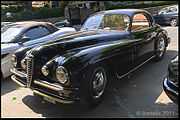
6C 2500S Touring
-
6C 2500 SS Coupé Pininfarina
-

6C 2500 Sport Touring Berlinetta (1939)
6C 3000 (1950–1954)

A 6C 3000 was prototype made in 1950, basically a 2500 with a 3L engine. It did not appear until 1952, as the Competizione Maggiorata (CM), built for racing, with a 3.5L engine, in four coupé and two spider versions.
Versions
- 6C 3000 (1948)
- 6C 3000 50 (1950)
- 6C 3000 CM (1952) 275 bhp (205 kW), 250 km/h (160 mph) ("Competizione Maggiorata" for enlarged displacement)
- 6C 3000 PR (1954) ("Passo Ridotto" for shortened wheelbase)
6C 3000 Competizione Maggiorata
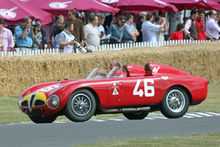
6C 3000 Competizione Maggiorata was born in 1952. The body was shaped by Carrozzeria Colli,[12][28] a coachbuilder from Milan, with some remembrances from the style introduced by 1900 Disco Volante. The propulsion system of this model comes from a project by Giuseppe Busso. It was different from his ancestor: it still used several components of the 3-liters-volume/6-cylinders system from the 6C 3000 prototype, but engine capacity was increased to 3495 cc. After several evolutions, it reached a power of 275 bhp (205 kW).
3000 CM was realised in six copies: four coupé and two spider. With the coupé model Juan Manuel Fangio and Giulio Sala got the second position at Mille Miglia, in 1953.[29] Fangio was leading the race, but a problem with the steering obliged him to slow down. Still with Fangio, the spider won the First Gran Premio Supercorte Maggiore in Meran, 1953; this car is shown today at Museo Storico Alfa Romeo.
One of the two spider was modified to cope with the new rules of the International Sport Category and the capacity was limited to 3-liters. This car was renamed PR, Passo Ridotto (Reduced Wheelbase).[29] This second spider belongs to the Museo Storico Alfa Romeo’s collection.
During the sixties, at the end of the period of competitions, 6C 3000 CM was used by the Experience Department of Alfa Romeo for testing new components, one of which is the disc brake, which is still present today in this vehicle.
Notes
- ↑ He had already led an Alfa Romeo 8C 2300B Mille Miglia in 1937
References
- ↑ 1.0 1.1 www.autoevolution Alfa Romeo introduced the 6C 1500 model in 1926, with full production beginning a year later. - Retrieved 02/01/2015
- ↑ Fusi 1978, p. 113.
- ↑ 3.0 3.1 "Zagato Alfa Romeo 6C 1750". coachbuild.com. Retrieved 2012-01-20.
- ↑ 4.0 4.1 Simeone, Frederick. "1929 Alfa Romeo 6C 1750 SS". Simeone Foundation Automotive Museum. Retrieved 10 March 2015.
- ↑ "Classic Alfa Romeo 6C review". telegraph.co.uk. Retrieved 2012-01-20.
- ↑ 6.0 6.1 "1933 Alfa Romeo 6C 1900 Gran Turismo". carfolio.com. Retrieved 2012-01-20.
- ↑ "6C 2003 B Gran Turismo". 6c2500.org. Retrieved 2012-01-20.
- ↑ "6C 2300 Pescara". 6c2500.org. Retrieved 2012-01-20.
- ↑ Fusi 1978, p. 251.
- ↑ "6C 2003 B Pescara". 6c2500.org. Retrieved 2012-01-20.
- ↑ Fusi 1978, p. 277.
- ↑ 12.0 12.1 12.2 12.3 "Alfa Romeo 6C 2500 SS Bertone Coupe". ultimatecarpage.com. Retrieved 2012-01-20.
- ↑ "256". 6c2500.org. Retrieved 2012-01-20.
- ↑ "1946 Alfa Romeo 6C 2500 'Freccia d'Oro'". imcdb.org. Retrieved 6 December 2014.
- ↑ "100 years of automobile revue". italiaspeed.com. Retrieved 2007-06-07.
- ↑ "Coloniale". 6c2500.org. Retrieved 2012-01-20.
- ↑ {{cite web |url=http://www.6c2500.org/page/?id=25 |title=Sport |website=6c2500.org |accessdate=2012-01-20}
- ↑ "Super Sport". 6c2500.org. Retrieved 2012-01-20.
- ↑ "1939 Alfa Romeo 6C 2500 SS Corsa". supercars.net/cars/. Retrieved 2008-08-30.
- ↑ "Model Story". 6c2500.org. Retrieved 2013-10-09.
- ↑ "Sport "Freccia d'oro"". 6c2500.org. Retrieved 2012-01-20.
- ↑ "Gran Turismo". 6c2500.org. Retrieved 2012-01-20.
- ↑ "Competizione". 6c2500.org. Retrieved 2012-01-20.
- ↑ "Specifications: Alfa Romeo 6C 2500 Sport Freccia D'oro". uniquecarsandparts.com.au. Retrieved 2012-01-20.
- ↑ "1949 Alfa Romeo 6C 2500 Villa d'Este". supercars.net. Retrieved 2007-06-07.
- ↑ "Alfa Romeo "6C 2500 Coloniale"". esercito.difesa.it (in Italian). Retrieved 2012-01-16.
- ↑ 27.0 27.1 Fusi 1978, pp. 397–400.
- ↑ "Alfa Romeo 6C 3000 CM Colli Spider". ultimatecarpage.com/car. Retrieved 2009-06-25.
- ↑ 29.0 29.1 "Alfa Romeo Museum cars take centre stage at Goodwood". italiaspeed.com. 2009. Retrieved 2009-07-08.
Bibliography
External links
| Alfa Romeo Automobiles S.p.A., a subsidiary of the Fiat S.p.A. since 1986, car timeline, 1910s–1940s — next » | ||||||||||||||||||||||||||||||||||||||||
|---|---|---|---|---|---|---|---|---|---|---|---|---|---|---|---|---|---|---|---|---|---|---|---|---|---|---|---|---|---|---|---|---|---|---|---|---|---|---|---|---|
| Type | 1910s | 1920s | 1930s | 1940s | ||||||||||||||||||||||||||||||||||||
| 0 | 1 | 2 | 3 | 4 | 5 | 6 | 7 | 8 | 9 | 0 | 1 | 2 | 3 | 4 | 5 | 6 | 7 | 8 | 9 | 0 | 1 | 2 | 3 | 4 | 5 | 6 | 7 | 8 | 9 | 0 | 1 | 2 | 3 | 4 | 5 | 6 | 7 | 8 | 9 | |
| 4-cyl. | 12 HP / 15 HP / 24 HP / 15-20 HP / 20-30 HP | RM | ||||||||||||||||||||||||||||||||||||||
| 20/30 HP / 20-30 ES | ||||||||||||||||||||||||||||||||||||||||
| 40/60 HP | ||||||||||||||||||||||||||||||||||||||||
| 6-cyl. | G1 / G2 | RL | ||||||||||||||||||||||||||||||||||||||
| 6C - 1500 / 1750 / 1900 / 2300 / 2500 | ||||||||||||||||||||||||||||||||||||||||
| 8-cyl. | 8C - 2300 / 2600 / 2900 | |||||||||||||||||||||||||||||||||||||||
| Racing car |
GP | P1 / P2 | Tipo A | Tipo B (P3) | Tipo C (8C-35) | Tipo 308/312/316 | 158 / 159 Alfetta | |||||||||||||||||||||||||||||||||
| Bi-motore | 12C | Tipo 512 | ||||||||||||||||||||||||||||||||||||||
| « previous — Alfa Romeo Automobiles S.p.A., a subsidiary of Fiat S.p.A. since 1986, car timeline, 1950s–1970s — next » | ||||||||||||||||||||||||||||||||
|---|---|---|---|---|---|---|---|---|---|---|---|---|---|---|---|---|---|---|---|---|---|---|---|---|---|---|---|---|---|---|---|---|
| Type | 1950s | 1960s | 1970s | |||||||||||||||||||||||||||||
| 0 | 1 | 2 | 3 | 4 | 5 | 6 | 7 | 8 | 9 | 0 | 1 | 2 | 3 | 4 | 5 | 6 | 7 | 8 | 9 | 0 | 1 | 2 | 3 | 4 | 5 | 6 | 7 | 8 | 9 | |||
| Small family car | Dauphine | Alfasud | ||||||||||||||||||||||||||||||
| Compact executive car | Giulietta (750/101) | |||||||||||||||||||||||||||||||
| Giulia | Giulietta (116) | |||||||||||||||||||||||||||||||
| Executive car | 1750 Berlina | Alfetta | ||||||||||||||||||||||||||||||
| 2000 Berlina | Alfetta 2000 | |||||||||||||||||||||||||||||||
| 1900 | 2000 | 2600 | Alfa 6 | |||||||||||||||||||||||||||||
| Coupé | Giulietta Sprint | GT Junior | Alfasud Sprint | |||||||||||||||||||||||||||||
| Giulia Sprint GT/1750 GTV/2000 GTV | Alfetta GT and GTV | |||||||||||||||||||||||||||||||
| 1900 Sprint | 2000 Sprint | 2600 Sprint | ||||||||||||||||||||||||||||||
| Cabriolet | 1900 | Giulia GTC | ||||||||||||||||||||||||||||||
| Spider | Giulietta Spider | Giulia Spider | Spider | |||||||||||||||||||||||||||||
| 2000 Spider | 2600 Spider | |||||||||||||||||||||||||||||||
| Roadster | Gran Sport Quattroruote | |||||||||||||||||||||||||||||||
| Sports car | 6C 2500 | Montreal | ||||||||||||||||||||||||||||||
| 33 Stradale | ||||||||||||||||||||||||||||||||
| Racing car | TZ | GTA | ||||||||||||||||||||||||||||||
| 158/159 | Tipo 33 | 177 | ||||||||||||||||||||||||||||||
| Off-road | Matta | |||||||||||||||||||||||||||||||
| LCV | Romeo | Romeo 2 | Romeo 3 | F11/F12/A11/A12 | ||||||||||||||||||||||||||||
| AR8 | ||||||||||||||||||||||||||||||||






